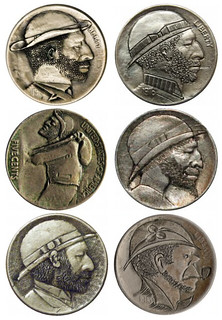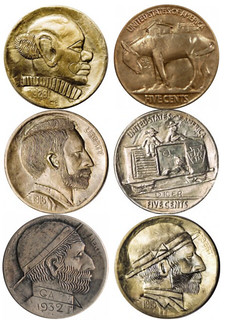
PREV ARTICLE
NEXT ARTICLE
FULL ISSUE
PREV FULL ISSUE
ORIGIN OF HOBO NICKELS AND EARLY NICKEL CARVERS
Ever wonder why it is that the Indian Head or "Buffalo" nickel is such a magnet for artists? A new brochure issued by the
Original Hobo Nickel Society (OHNS) sheds some light on this. Thanks to Ralph Winter for forwarding a copy and allowing us to republish
some of the text here. -Editor
The head on the new buffalo nickel was a man. The heads on nearly all earlier coins were of women (Liberty heads, Barber and Morgan heads). A male head has larger and more rugged features (nose, chin, and brow) that can be altered in many ways. Either side of the host coin could be transformed by punching, carving or engraving into limitless number of designs. Often the buffalo reverse was altered into another animal or a man with a backpack. This was the origin of what we today call hobo nickels. The standard hobo nickel has the Indian’s head altered into a man wearing a rounded derby style hat, with a beard, ear, and collar(s). Nicer specimens may have the profile changed, and possibly a cigar, cigarette, or wording added. Although usually referred to as “hobo nickels,” they are also sometimes referred to as “reworked,” “transformed,” “bum nickels,” “trench art,” or “prisoner nickels.”
Although the names of the majority of these early carvers have been lost over time, their distinctive carving styles have made it
possible to identify the works of specific individuals. The Original Hobo Nickel Society (OHNS) has provided nicknames for some of these
artists. One of the better known of these is “Peanut Ear.”
In 1981 Delma (Del) K. Romines published a series of articles about hobo nickels in COIN WORLD magazine and then published the book HOBO NICKELS in 1982. These articles and books spawned a new generation of hobo nickel carvers, some of whom copied earlier classic designs from photos which had appeared in Del’s book. A second book, The Hobo Nickel was published in 1996 with Del’s wife, Joyce Ann Romines, listed as the author. One of the best known early carvers was a hobo named George Washington “Bo” Hughes. “Bo” had originally been taught by another hobo carver named Bertram “Bert” Wiegand. “Bo” produced a large body of work, but carvings produced after a hand injury in 1957 were of lesser quality. Bert Top four nickels are by George Washington “Bo” Hughes. The bottom two are by Bert Wiegand. did not produce as large a body of work (carved nickels) as “Bo,” but the ones that have survived are all of Superior quality. For more information on the Original Hobo Nickel Society, see:
Wayne Homren, Editor The Numismatic Bibliomania Society is a non-profit organization promoting numismatic literature. See our web site at coinbooks.org. To submit items for publication in The E-Sylum, write to the Editor at this address: whomren@gmail.com To subscribe go to: https://my.binhost.com/lists/listinfo/esylum All Rights Reserved. NBS Home Page Contact the NBS webmaster 
|

